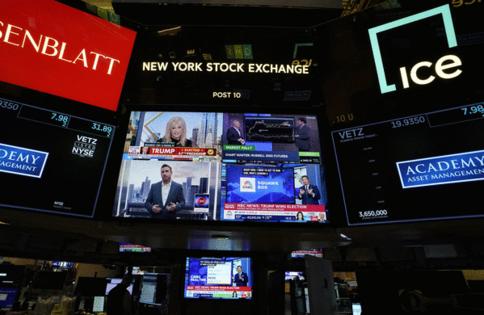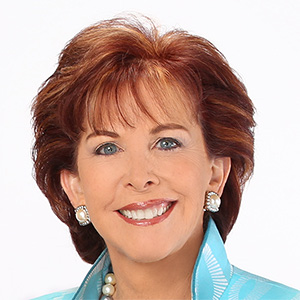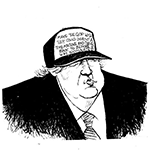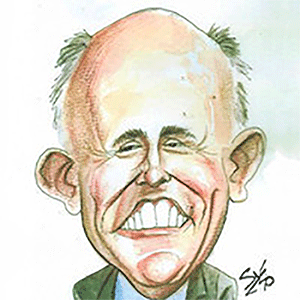High-conviction Wall Street bets unravel in 'Trump trade' rebuke
Published in Business News
Coming into the new presidency the playbook for traders was obvious. Bet it all on a core of America First-linked champions, from Tesla Inc. and crypto to smaller companies.
Turns out, amid spiraling policy shifts and worsening economic data, whittling yourself down to just a few bold calls has been one of the worst things to do in the era of Donald Trump.
That’s bad news for followers of this approach — including would-be market timers and those with concentrated portfolios — after another crushing week on Wall Street.
As trade tensions flared, risk bulls were hit Friday by reports showing that consumer confidence plunged and inflation ticked up — just before tariff ‘Liberation Day.’ The Nasdaq 100 sank 2.6%, Treasuries jumped, a gauge of credit risk rose, and gold hit yet another record.
Altogether, it’s a fresh gut-punch for investors wedded to big macro bets on one-shot themes, like America First trading or the Big Tech era. Few escaped unscathed but, once again, institutional pros who’ve long touted the virtues of spreading out market bets fared the best.
“We’ve got persistently elevated inflation, geopolitical risk, and every day the recessionary risk continues to climb,” said David Schassler, the head of multi-asset solutions for investment manager VanEck. “The worst thing you can do as an allocator is have any binary bets in your portfolio. Diversification’s absolutely essential.”
Multi-faceted portfolios are outperforming anew, including those packing in systematic-like trades, inflation-hedged assets like commodities and other physical assets, and cheap — rather than expensive — securities. It’s a diverse group of market winners, but call this the real Trump trade: dynamic hedging for the era of policy uncertainty.
Signs of softening growth and sticky inflation have turned previously reliable trades into losers. Friday data showed inflation expectations jumping to a 32-year high, just as key gauge of price pressures picked up, with weaker-than-forecast consumer spending. Economists are dialing back estimates for how much U.S. gross domestic product will rise while increasing inflation predictions. On Wednesday, Trump announced a 25% levy on auto imports and is promising a bevy of reciprocal tariffs on April 2.
Rather than restore calm, a parade of Fed officials warned this week about how their job is being made harder by the trade war. Boston Fed’s President Susan Collins said it’s “inevitable” inflation will be boosted by tariffs, at least in the near term, while St. Louis Fed President Alberto Musalem said policymakers should be wary of assuming their price impact will pass quickly.
The S&P 500 fell 1.5% on the week, leaving it poised for a 5% drop in the January-to-March period, while Magnificent Seven bloc is on pace for the worst first quarter in at least a decade. At the same time, the start of 2025 will go down as the best stretch in years for strategies that allocate across asset classes. A proxy for that, the S&P Multi-Asset Risk Parity Index, beat the S&P 500 by more than 7 percentage points in the quarter, the most since 2018.
Traders searching for upside in volatile markets are generally succeeding to the extent they avoid concentrated positions, specifically indexes like the S&P 500 and Nasdaq 100, where a handful of giant companies dominate returns. Active large-cap growth mutual funds with over 40% allocation to Magnificent 7 stocks have tumbled 8% on average so far this year, according to an analysis by Bloomberg Intelligence’s David Cohne. By contrast, a quant trade that tracks investment factors across asset classes, is up 3.5%, according to a Societe Generale SA gauge of alternative-risk premia.
“If this market backdrop holds with uncertainty in the spotlight, we think it’s a bull market for diversifiers,” said Paisley Nardini, asset allocation strategist at Simplify Asset Management. “The start of 2025 has been focused on the rotation trade, rewarding some of the unloved parts of the market.”
Haven assets have also delivered, most notably gold, hitting a succession of records this year and is on its way to a 17% quarterly gain, the most since 1986. Investors have plowed more than $12 billion into major gold exchange-traded funds in the past two months, the most since 2020.
The VanEck Real Assets ETF (RAAX) has beaten the S&P 500 so far in 2025, in part thanks to Schassler’s decision to crank up the gold allocation to the max some three years ago. He predicts bullion will hit as much as $5,000 in the next 18 to 24 months.
Many on Wall Street have also quickly shifted to risk-off positioning. HSBC chief multi-asset strategist Max Kettner downgraded U.S. stocks, investment-grade credit and junk bonds to underweight this week because of deteriorating U.S. data and the flurry of tariff announcements. The bank also extended its gold overweight even further on stagflation-like risks. Yet, despite the sharp tilt against U.S. assets, HSBC is not ready to call an end to the winning trades of the past two years.
“We are tactically much more cautious and are sellers of U.S. equities and U.S. risk assets in general,” Kettner said. “But calling for an end to U.S. exceptionalism from a longer-term and structural perspective is greatly exaggerated in our view.”
_____
©2025 Bloomberg News. Visit at bloomberg.com. Distributed by Tribune Content Agency, LLC.












Comments